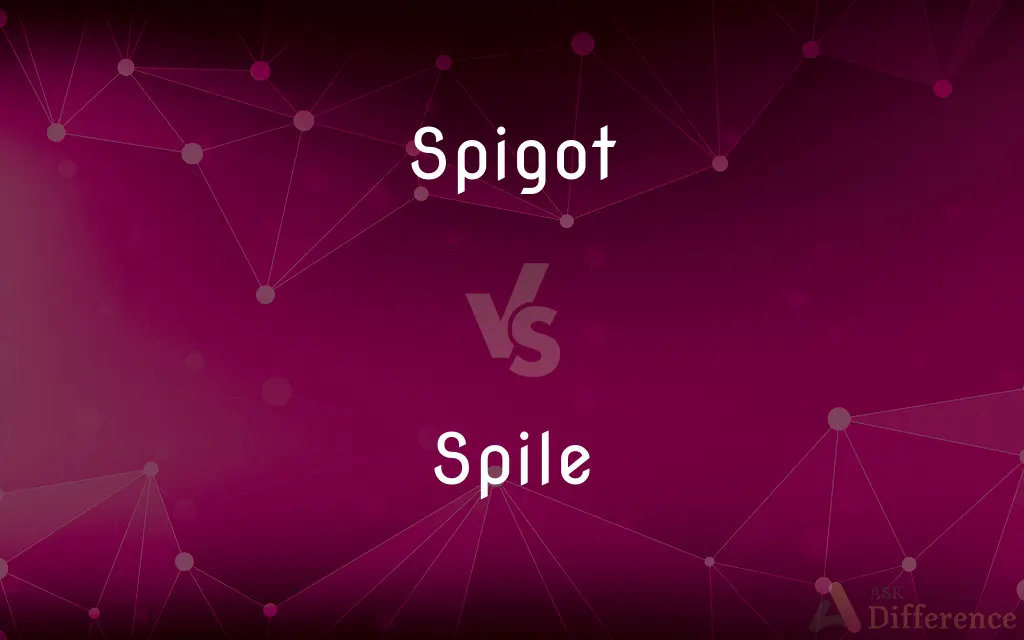Spigot vs. Spile — What's the Difference?
Edited by Tayyaba Rehman — By Urooj Arif — Updated on April 8, 2024
A spigot is a valve for controlling liquid flow, commonly in beer taps or water barrels, whereas a spile is a peg or plug for controlling flow or for tapping trees.

Difference Between Spigot and Spile
Table of Contents
ADVERTISEMENT
Key Differences
A spigot, typically found in kegs, barrels, and containers, serves as a valve to control the flow of liquids such as water or beer, offering precise control and easy access. On the other hand, a spile is traditionally a wooden peg used to control the flow of liquid in barrels, but it's also known for its role in tapping maple trees to collect sap.
The use of spigots is common in both domestic and commercial settings for dispensing a variety of liquids, whereas spiles hold a specialized role in certain brewing processes and maple syrup production.
While spigots are engineered for repeated use and can be made from various materials like metal or plastic, spiles are often made of wood or metal and are designed for specific tasks such as venting casks or tapping trees.
In the context of brewing and beverage dispensing, spigots provide a durable and reusable solution for controlling liquid flow, whereas spiles may be used temporarily or as a traditional alternative for specific purposes.
The choice between a spigot and a spile often depends on the specific application, with spigots being favored for their durability and ease of use in a wide range of settings, while spiles are chosen for their traditional appeal and specialized functions.
ADVERTISEMENT
Comparison Chart
Primary Use
Controlling liquid flow in kegs and containers
Tapping trees or venting barrels
Material
Metal, plastic
Wood, metal
Application
Domestic and commercial
Brewing, maple syrup production
Durability
Designed for repeated use
May be used temporarily or for specific tasks
Specificity
General use in liquid dispensing
Specialized for tapping or venting
Compare with Definitions
Spigot
Engineered for long-term use.
The new spigot model boasts improved durability and ease of use.
Spile
Often made of wood for traditional purposes.
The wooden spile was carved specifically for tapping.
Spigot
A valve for serving drinks, especially beer.
The bartender cleaned the spigot before tapping a new keg.
Spile
A tool for venting casks.
The brewer inserted a spile into the barrel to allow gas to escape.
Spigot
Made of various materials like metal or plastic.
The stainless steel spigot was chosen for its durability.
Spile
Specifically used for extracting sap.
Maple syrup production begins with inserting a spile into the tree.
Spigot
A device for controlling the flow of liquid from a container.
The spigot on the beer keg was opened to start serving.
Spile
A peg or plug for controlling the flow of liquid or for tapping trees.
They used a spile to tap the maple tree for syrup.
Spigot
A faucet used for releasing water from a system.
He turned the spigot to fill his water bottle.
Spile
Utilized for special tasks.
A spile was placed temporarily to vent the fermenting beer.
Spigot
A faucet. See Note at andiron.
Spile
A spile is a small wooden or metal peg used to control the flow of air into, and carbon dioxide out of, a cask of ale. Spiles can also be used to broach water from trees.
Spigot
A wooden faucet placed in the bunghole of a cask.
Spile
A post used as a foundation; a pile.
Spigot
The male end of a segment of pipe.
Spile
A wooden plug; a bung.
Spigot
A pin or peg used to stop the vent in a cask.
Spile
A spout used in taking sap from a tree.
Spigot
The plug of a faucet, tap or cock.
Spile
To support with a spile.
Spigot
A water tap: a faucet or sillcock.
Spile
To plug or tap with a spile.
Spigot
(transitive) To block with a spigot.
Spile
A splinter.
Spigot
(transitive) To insert (a spigot).
Spile
A spigot or plug used to stop the hole in a barrel or cask.
Spigot
A pin or peg used to stop the vent in a cask; also, the plug of a faucet or cock.
Spile
(US) A spout inserted in a maple (or other tree) to draw off sap.
Spigot
A faucet for drawing water from a pipe or cask
Spile
A pile; a post or girder.
Spigot
A plug for a bunghole in a cask
Spile
To plug (a hole) with a spile.
Spile
To draw off (a liquid) using a spile.
Spile
To provide (a barrel, tree etc.) with a spile.
Spile
(transitive) To support by means of spiles.
Spile
(transitive) To drive piles into.
Spile
Spoil.
Spile
A small plug or wooden pin, used to stop a vent, as in a cask.
Spile
A small tube or spout inserted in a tree for conducting sap, as from a sugar maple.
Spile
A large stake driven into the ground as a support for some superstructure; a pile.
Spile
To supply with a spile or a spigot; to make a small vent in, as a cask.
Spile
A column of wood or steel or concrete that is driven into the ground to provide support for a structure
Spile
A plug used to close a hole in a barrel or flask
Common Curiosities
What is a spigot?
A spigot is a valve or faucet designed to control the flow of liquid from a container or system.
Are spigots and spiles interchangeable?
No, spigots and spiles serve different purposes and are not typically interchangeable.
What is the primary purpose of a spile?
Spiles are primarily used for tapping trees like maples for sap or venting barrels in brewing processes.
What is a spile?
A spile is a peg or plug used for controlling liquid flow in barrels or for tapping trees to collect sap.
How is a spile used in maple syrup production?
A spile is inserted into a drilled hole in a maple tree to allow sap to flow out for collection.
Can a spigot be used on any container?
Spigots can be attached to a wide range of containers as long as there's a proper fit and seal.
Is a spile necessary for brewing beer?
Spiles are used in traditional cask brewing to vent the cask, but modern brewing often uses other methods.
Where are spigots commonly used?
Spigots are widely used in domestic and commercial settings for dispensing beverages and water.
How do you clean a spigot?
Cleaning a spigot typically involves disassembling it (if possible) and using soap and water or specialized cleaning solutions.
Can a spigot be made of wood?
While spigots are usually made of metal or plastic for durability, there are no standard wooden spigots due to durability concerns.
Do spiles have any modern applications?
Beyond traditional uses, spiles can be used in homemade brewing setups and DIY maple syrup tapping.
Can spigots be used outdoors?
Yes, spigots are often used outdoors, especially for garden hoses and outdoor water dispensers.
What materials are spiles made from?
Spiles can be made from wood or metal, depending on their intended use.
How do you install a spile?
Installing a spile often involves drilling a hole and gently tapping the spile into place.
What's the difference in maintenance between a spigot and a spile?
Spigots may require regular cleaning and occasional replacement of parts, whereas spiles are typically low-maintenance but may be single-use or require simple cleaning.
Share Your Discovery

Previous Comparison
Mud vs. Peat
Next Comparison
Clover vs. ClubAuthor Spotlight
Written by
Urooj ArifUrooj is a skilled content writer at Ask Difference, known for her exceptional ability to simplify complex topics into engaging and informative content. With a passion for research and a flair for clear, concise writing, she consistently delivers articles that resonate with our diverse audience.
Edited by
Tayyaba RehmanTayyaba Rehman is a distinguished writer, currently serving as a primary contributor to askdifference.com. As a researcher in semantics and etymology, Tayyaba's passion for the complexity of languages and their distinctions has found a perfect home on the platform. Tayyaba delves into the intricacies of language, distinguishing between commonly confused words and phrases, thereby providing clarity for readers worldwide.
















































